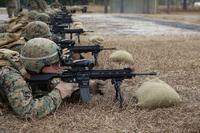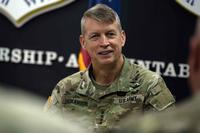The admiral in charge of U.S. Pacific Command said China's introduction of HQ-9 surface-to-air missiles, radar system and 10,000-foot runway on contested islands within the South China Sea represented militarization in violation of national protocols.
In a hearing before the Senate Armed Services Committee, Navy Adm. Harry Harris called for continued freedom-of-navigation movements through the region to reinforce U.S. rights and discredit China's attempted power grab.
The hearing came a week after reports surfaced that China had deployed the surface-to-air missiles to Woody Island, the largest island in the Paracel chain in the South China Sea.
Harris, who has led PACOM for seven months, said the move did not surprise him at all.
"In my opinion China is clearly militarizing the South China Sea, and you have to believe in a flat earth to think otherwise," he told the panel.
Asked by Sen. Angus King, an Independent from Maine, why he believed China would take such a step at odds with international convention, Harris was blunt.
"I believe China seeks hegemony in East Asia," he said.
The push to militarize the South China Sea comes as North Korea makes headlines with nuclear and ballistic missile demonstrations that threaten to further destabilize the region and potentially trigger an international incident.
The commander of U.S. Forces Korea, Army Gen. Curtis Scaparrotti, who testified alongside Harris, said tensions around the rogue state rose to the highest they have been in more than 20 years last August, when two South Korean soldiers were wounded by a North Korean landmine, ratcheting up hostilities between the two nations until a standoff could be reached.
Scaparrotti said his command would soon begin bilateral consultations on the feasibility of deploying the Terminal High Altitude Area Defense, or THAAD, missile system to South Korea to join the Patriot missile system in providing protection for the U.S. and Korea and answering North Korean saber-rattling.
Meanwhile, Harris said, China's provocations called for a calm strategy that emphasized U.S. alliances in the region and its military strength.
"I believe that we should maintain our credible combat power; we should maintain a network of like-minded allies and partners; we should continue to exercise our rights on the high seas and the air space above it, and we should encourage our friends, partners, and allies to do the same," he said.
Harris acknowledged to committee chairman John McCain, a Republican from Arizona, that certain Chinese weapons might potentially pose a threat to the U.S. carrier strike group in the region, particularly the DF-21 medium-range ballistic missile and the DF-26 intermediate-range ballistic missile, now under development.
"I think, though, that our carriers are resilient and we have the ability to do what needs to be done if it comes to that," Harris said.
For the U.S., the Chinese decision to militarize in the South China Sea may have at least one positive outcome, he said.
"I believe that China's actions are provocative, increase tensions and cause nations in the region to look to the U.S. as the security partner of choice, and away from China," Harris said.
-- Hope Hodge Seck can be reached at hope.seck@military.com. Follow her on Twitter at @HopeSeck.




























